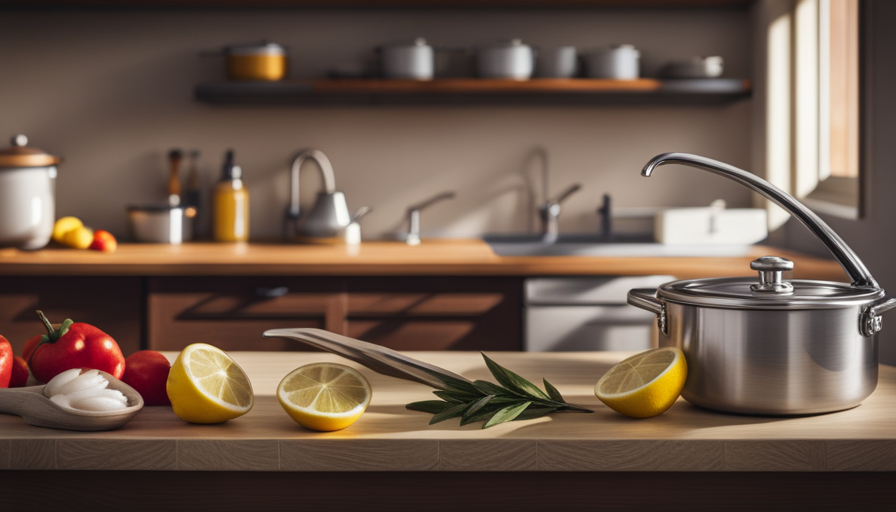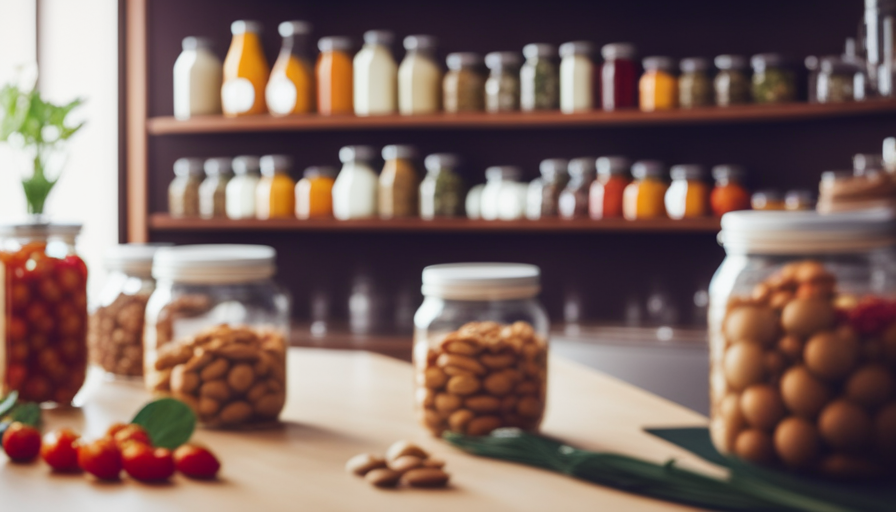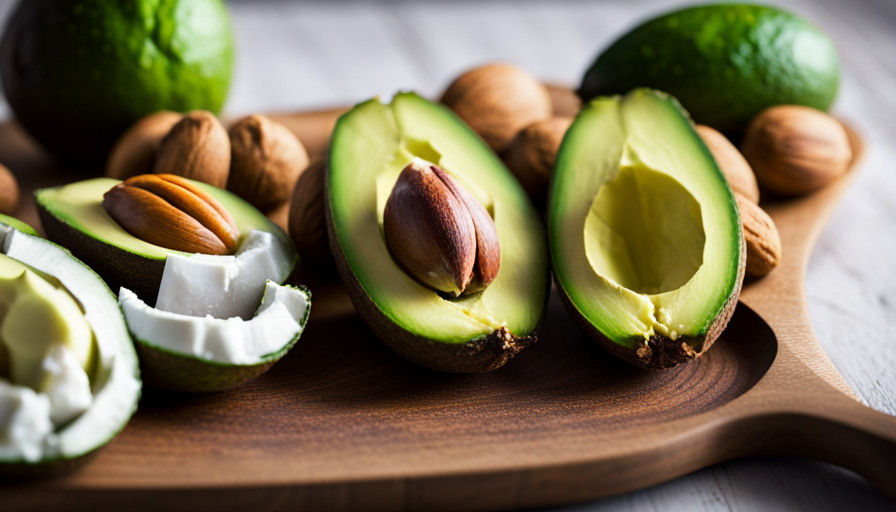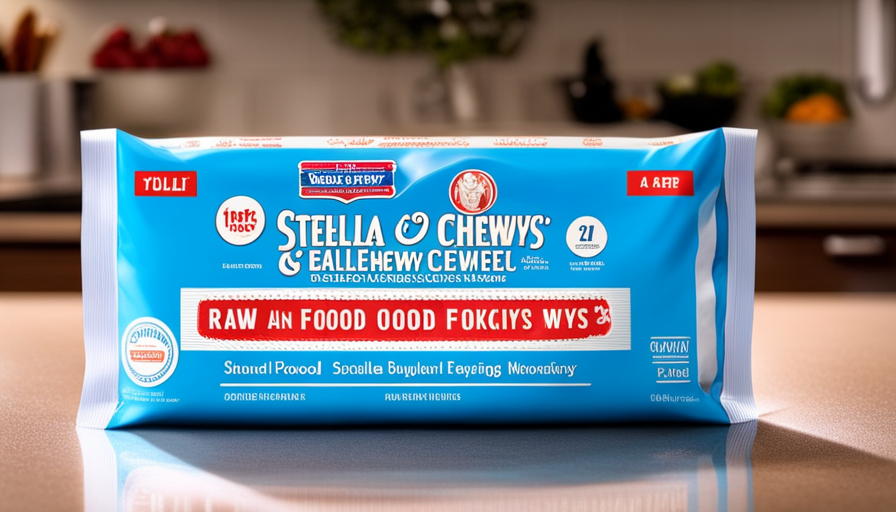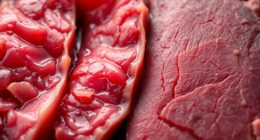Picture enjoying a delicious meal of juicy, tasty chicken. But now, envision a situation where this enjoyable moment quickly turns into a painful experience with stomach cramps, vomiting, and diarrhea. Consuming undercooked chicken can lead to foodborne illnesses, serious and sometimes deadly conditions caused by harmful bacteria like Salmonella and Campylobacter.
However, fear not! By following a few simple steps, you can prevent food poisoning and keep yourself and your loved ones safe. Properly handling and storing raw chicken, cooking it thoroughly, and avoiding cross-contamination are just a few of the crucial practices that will help you steer clear of the dangers lurking in raw poultry.
So, let’s dive into the world of chicken safety and discover how to protect yourself from the perils of consuming undercooked poultry.
Key Takeaways
- Proper hygiene and handling of raw chicken are crucial to prevent food poisoning.
- Cross-contamination should be avoided by keeping raw chicken separate from other foods, utensils, and surfaces.
- Thoroughly cooking chicken to an internal temperature of 165°F (74°C) is important to kill any bacteria.
- Proper handling and storage of raw chicken include refrigerating it below 40°F (4°C) and consuming or cooking it within two days of purchase.
Understanding the Risks of Consuming Raw Chicken
Consuming raw chicken can lead to severe food poisoning, so it’s crucial to understand the risks involved. One of the main risks of consuming raw chicken is the potential presence of salmonella. Salmonella is a type of bacteria commonly found in raw poultry, including chicken. When consumed, it can cause symptoms such as diarrhea, abdominal pain, fever, and vomiting. In severe cases, it can even lead to hospitalization or death, especially in vulnerable individuals like young children, pregnant women, and the elderly.
Proper hygiene plays a key role in preventing food poisoning from raw chicken. It’s important to handle raw chicken with care and avoid cross-contamination. This means keeping raw chicken separate from other foods, utensils, and surfaces to prevent the spread of bacteria. Thoroughly washing your hands before and after handling raw chicken is also essential.
Additionally, it’s crucial to cook chicken thoroughly to kill any bacteria that may be present. The recommended internal temperature for chicken is 165°F (74°C). Using a food thermometer can help ensure that the chicken is cooked to the proper temperature.
By understanding the risks of salmonella and the importance of proper hygiene, you can take the necessary precautions to prevent food poisoning after consuming raw chicken. It’s always better to be safe than sorry when it comes to your health, so remember to handle and cook raw chicken with utmost care.
Proper Handling and Storage of Raw Chicken
By treating raw chicken like a ticking time bomb, you’ll ensure it’s safe handling and storage.
Proper handling and storage of raw chicken is essential to prevent food poisoning and the growth of harmful bacteria. To maintain storage safety, always keep raw chicken refrigerated at a temperature below 40°F (4°C). Place the chicken in a leak-proof bag or container to prevent cross-contamination with other foods. It’s important to store raw chicken on the bottom shelf of the refrigerator to prevent any juices from dripping onto other items.
When handling raw chicken, always wash your hands thoroughly with soap and warm water before and after. This’ll help minimize the risk of spreading bacteria. Additionally, use separate cutting boards, utensils, and plates for raw chicken to avoid cross-contamination with other ingredients. Clean these items with hot, soapy water, or run them through the dishwasher after use.
To prevent bacterial growth, it’s crucial to consume or cook raw chicken within two days of purchase. If you’re not planning to use it within that timeframe, freeze it. Make sure to place the chicken in a freezer-safe container or bag, removing as much air as possible to prevent freezer burn.
By following these storage and handling guidelines, you’ll greatly reduce the risk of food poisoning from raw chicken. Stay vigilant and prioritize safety to ensure a healthy and enjoyable dining experience.
Thoroughly Cooking Chicken to Kill Harmful Bacteria
When you cook chicken thoroughly, you ensure that harmful bacteria are eliminated, guaranteeing a safe and satisfying meal. Killing bacteria is crucial to prevent food poisoning after consuming raw chicken.
To achieve this, it’s vital to follow proper cooking techniques. The most effective method is to use a food thermometer to ensure that the internal temperature of the chicken reaches 165°F (74°C). Insert the thermometer into the thickest part of the meat, avoiding contact with bones or fat.
Another technique is to visually check the chicken for doneness. The meat should be opaque and white throughout, with no pink or red areas. Juices should run clear, not pink or bloody.
It’s essential to avoid undercooking or partially cooking chicken, as this can leave behind harmful bacteria. By cooking chicken thoroughly, you minimize the risk of foodborne illnesses and create a safe environment for yourself and your loved ones.
So remember, always cook your chicken until it reaches the appropriate temperature, and visually inspect it to ensure it’s fully cooked.
Using a Food Thermometer to Ensure Safe Cooking Temperatures
Using a food thermometer is the key to guaranteeing a safe and delicious meal by ensuring that the chicken is cooked to the proper temperature. Food safety is of utmost importance when it comes to cooking chicken, as consuming undercooked chicken can lead to food poisoning and other health risks.
By using a food thermometer, you can accurately measure the internal temperature of the chicken and make sure it reaches the safe minimum temperature of 165°F (74°C) to kill any harmful bacteria that may be present.
Here are three reasons why using a food thermometer is crucial for food safety and proper cooking techniques:
-
Accuracy: By relying on a food thermometer, you can accurately determine the internal temperature of the chicken, leaving no room for guesswork. This ensures that the chicken is thoroughly cooked and safe to consume.
-
Prevention of foodborne illnesses: Cooking chicken to the proper temperature is essential for killing harmful bacteria such as Salmonella and Campylobacter. These bacteria can cause food poisoning if ingested, leading to symptoms like nausea, vomiting, diarrhea, and abdominal pain.
-
Consistency: Using a food thermometer allows you to consistently cook chicken to the correct temperature every time. This helps in achieving a delicious and safe meal, as undercooked chicken can be a breeding ground for bacteria.
By incorporating a food thermometer into your cooking routine, you can ensure food safety and prevent the risk of foodborne illnesses. Remember, it’s better to be safe than sorry when it comes to cooking chicken.
Avoiding Cross-Contamination in the Kitchen
To ensure the safety of your meals, it’s important to be mindful of cross-contamination in the kitchen, where bacteria from raw foods can easily spread to other surfaces and utensils. Did you know that a study found that cross-contamination occurs in 90% of kitchen environments?
This statistic highlights the critical need for preventing cross-contamination, especially when handling raw chicken. One effective way to prevent cross-contamination is by using separate cutting boards for raw chicken and other foods. Raw chicken can contain harmful bacteria such as Salmonella or Campylobacter, which can easily transfer to other foods if the same cutting board is used. By dedicating one cutting board solely for raw chicken and another for fruits, vegetables, or cooked foods, you can significantly reduce the risk of spreading bacteria.
Another important measure to take is to thoroughly clean and sanitize all kitchen surfaces and utensils after they come into contact with raw chicken. This includes countertops, knives, and any other tools used during food preparation. Using hot, soapy water and sanitizing solutions can effectively kill bacteria and prevent their transfer to other surfaces.
Preventing cross-contamination is not only crucial in your own kitchen, but it is also vital in restaurants. Professional establishments must adhere to strict food safety regulations to protect their customers. By following these practices and being diligent about preventing cross-contamination, you can ensure the safety of your meals and reduce the risk of food poisoning after consuming raw chicken.
Washing Hands and Surfaces Properly
Now that you understand the importance of avoiding cross-contamination in the kitchen, let’s dive into the critical step of washing hands and surfaces properly to prevent food poisoning after eating raw chicken.
When it comes to handwashing, it’s crucial to follow proper techniques. Start by wetting your hands with warm water and applying soap. Rub your hands together vigorously for at least 20 seconds, making sure to clean all surfaces, including the back of your hands, between your fingers, and under your nails. Rinse your hands thoroughly under running water, and then dry them with a clean towel or air dry them.
In addition to handwashing, it’s essential to sanitize kitchen utensils and equipment. After using knives, cutting boards, or any other tools that come into contact with raw chicken, make sure to wash them with hot, soapy water. You can also use a diluted bleach solution or a sanitizing solution to ensure proper sanitation. It’s important to follow the manufacturer’s instructions for any sanitizing products you use.
By practicing proper handwashing techniques and sanitizing your kitchen utensils and equipment, you’re taking significant steps to prevent food poisoning after consuming raw chicken.
Stay tuned for the next subtopic, where we’ll discuss the importance of cooking chicken thoroughly.
Marinating Chicken Safely
When marinating chicken, make sure you follow these safety guidelines to ensure a flavorful and safe meal. Safe marinating techniques are crucial to prevent food poisoning from raw chicken.
First, always marinate chicken in the refrigerator, never at room temperature. Bacteria multiply rapidly in warm environments, so keeping the chicken chilled reduces their growth.
Additionally, never reuse marinades that have come into contact with raw chicken, as they can contain harmful bacteria. Always discard any leftover marinade and make a fresh batch for basting or serving.
Marinating time and temperature are also important factors to consider. It’s recommended to marinate chicken for no more than 24 hours in the refrigerator. Longer marinating times can break down the chicken’s texture and result in a mushy consistency.
Furthermore, make sure the internal temperature of the chicken reaches at least 165°F (74°C) before consuming it. This ensures that any harmful bacteria present in the raw chicken are killed off during the cooking process.
By following these safe marinating techniques and paying attention to marinating time and temperature, you can enjoy a flavorful and safe chicken meal without the risk of food poisoning.
Properly Reheating Leftover Chicken
Make sure you properly reheat your leftover chicken to maintain its flavor and texture, as studies show that reheating chicken at a temperature below 165°F (74°C) can increase the risk of bacterial contamination.
To ensure the safety of your leftover chicken, follow these best practices for reheating methods.
Firstly, if you have a microwave, it’s a convenient option for reheating chicken. Place the chicken on a microwave-safe plate and cover it with a microwave-safe lid or plastic wrap. Set the microwave to medium power and heat the chicken in short intervals, stirring or flipping it occasionally. Check the internal temperature with a food thermometer to make sure it reaches at least 165°F (74°C) before consuming.
Alternatively, you can also reheat your leftover chicken in the oven. Preheat the oven to 350°F (175°C) and place the chicken on a baking sheet. Cover it loosely with aluminum foil to prevent it from drying out. Heat the chicken for about 20-30 minutes or until it reaches an internal temperature of 165°F (74°C).
Remember, never use a slow cooker or chafing dish to reheat chicken as they may not heat the chicken evenly and could promote bacterial growth.
By following these reheating methods and best practices, you can enjoy your leftover chicken safely without the risk of food poisoning.
Recognizing the Symptoms of Food Poisoning
To keep yourself safe and in the know, it’s important for you to be able to recognize the symptoms of a potential bout of food poisoning. By being aware of the early signs, you can take prompt action to prevent further complications. Food poisoning can occur due to various reasons, but when it comes to raw chicken, the most common cause is the presence of harmful bacteria like Salmonella or Campylobacter. These bacteria can cause serious illness if ingested.
To help you identify the symptoms of food poisoning, here is a table that outlines some common signs to look out for:
| Symptoms | Description |
|---|---|
| Nausea | Feeling of queasiness or an upset stomach |
| Vomiting | Forceful expulsion of stomach contents |
| Diarrhea | Loose or watery bowel movements |
| Abdominal pain | Cramping or discomfort in the stomach area |
| Fever | Elevated body temperature |
If you experience any of these symptoms after consuming raw chicken, it is crucial to seek medical attention immediately. Remember, early recognition and treatment can make a significant difference in your recovery. Additionally, it’s important to practice good hygiene and proper cooking techniques to minimize the risk of food poisoning.
Seeking Medical Attention if Food Poisoning Occurs
If you experience any of these symptoms, it’s crucial for you to promptly seek medical attention in order to ensure your well-being and recovery. Food poisoning can be a serious condition, and it’s important to address it as soon as possible.
Seeking medical attention will not only help you receive the necessary treatment, but it can also provide documentation and evidence that can be helpful when seeking legal advice or dealing with insurance claims.
When you go to the doctor or seek medical attention, they’ll likely ask you about your symptoms and conduct a physical examination. They may also order tests, such as blood or stool samples, to confirm the presence of food poisoning. It’s important to be honest and thorough in providing information to the healthcare professionals, as this’ll aid in accurate diagnosis and appropriate treatment.
In addition to seeking medical attention, it’s also important to consider seeking legal advice if you believe that your food poisoning was a result of negligence or improper handling of the raw chicken. A lawyer can guide you through the process of filing a claim and seeking compensation for any damages or losses you may have suffered.
Dealing with insurance claims can also be a complex process. It’s important to document your medical expenses, any lost wages, and other damages related to the food poisoning. Providing this information to your insurance company can help ensure that you receive the appropriate coverage and compensation.
Seeking medical attention is crucial if you experience symptoms of food poisoning after consuming raw chicken. Additionally, seeking legal advice and dealing with insurance claims may be necessary in certain situations. Remember to keep documentation of your expenses and losses to support your claims.
Frequently Asked Questions
Can I eat raw chicken if it has been frozen?
Yes, you can eat raw chicken if it’s been properly frozen. Freezing chicken kills many harmful bacteria, reducing the risk of food poisoning. However, it’s crucial to handle and prepare frozen chicken safely. Thaw it in the refrigerator, not at room temperature, to prevent bacterial growth. Additionally, choosing organic chicken offers health benefits as it’s raised without antibiotics and hormones. Remember to always follow proper food safety guidelines when handling and consuming raw chicken.
Is it safe to consume raw chicken if it is organic or free-range?
It’s not safe to consume raw chicken, regardless of whether it’s organic or free-range. Raw chicken can contain harmful bacteria like salmonella, which can cause food poisoning. Organic and free-range chickens may have a lower risk of bacterial contamination due to their living conditions and feed, but they can still carry bacteria. To prevent food poisoning, it’s essential to cook chicken thoroughly to an internal temperature of 165°F to kill any potential bacteria.
What should I do if I accidentally ingest a small amount of raw chicken?
If you accidentally ingest a small amount of raw chicken, it’s important to take immediate action to prevent food poisoning. Watch out for symptoms such as nausea, vomiting, and diarrhea, which can occur within hours or days. Drink plenty of fluids to stay hydrated and rest to allow your body to recover.
If symptoms persist or worsen, seek medical attention. Remember to always handle and cook raw chicken properly to prevent foodborne illnesses.
Can I use the same cutting board for raw chicken and other ingredients?
To ensure food safety, it’s crucial to use separate cutting boards for raw chicken and other ingredients. This prevents cross-contamination and reduces the risk of foodborne illnesses.
Proper sanitization techniques for cutting boards are essential as well. After each use, wash the cutting board with hot, soapy water, and then sanitize it with a solution of one tablespoon of bleach per gallon of water. This helps eliminate any bacteria that may be present.
How long can I keep raw chicken in the refrigerator before it becomes unsafe to eat?
Raw chicken can be stored in the refrigerator for up to 2 days before it becomes unsafe to eat. It’s crucial to check the expiration date before consuming raw chicken, as it shouldn’t be consumed after it’s expired. Eating raw chicken can lead to food poisoning, so it’s always best to cook it thoroughly to kill any harmful bacteria. Remember to handle raw chicken with care to prevent cross-contamination.
Can Preparing Raw Food for Dogs Cause Food Poisoning?
Yes, preparing raw food dogs can potentially cause food poisoning. Raw meat can be contaminated with bacteria like Salmonella or E. coli, putting both the dog and its owner at risk of infection. It’s important to handle, store, and prepare raw food for dogs with caution to minimize this risk.
What Precautions Can I Take to Avoid Food Poisoning from Raw Chicken?
When dealing with raw chicken, it’s crucial to handle it carefully to prevent reducing raw oyster illness risk. Use separate cutting boards and utensils for raw chicken, and cook it to an internal temperature of 165°F. Also, wash your hands and any surfaces that come into contact with the raw chicken thoroughly.
Conclusion
In conclusion, you now have the knowledge to prevent food poisoning after indulging in raw chicken. By handling and storing it properly, thoroughly cooking it to kill harmful bacteria, and using a food thermometer to ensure safe cooking temperatures, you can greatly reduce the risk.
Remember to avoid cross-contamination, marinate safely, and properly reheat leftovers. If you experience any symptoms of food poisoning, don’t hesitate to seek medical attention.
Stay safe and enjoy your chicken without fear of the dreaded food poisoning monster lurking in the shadows.


